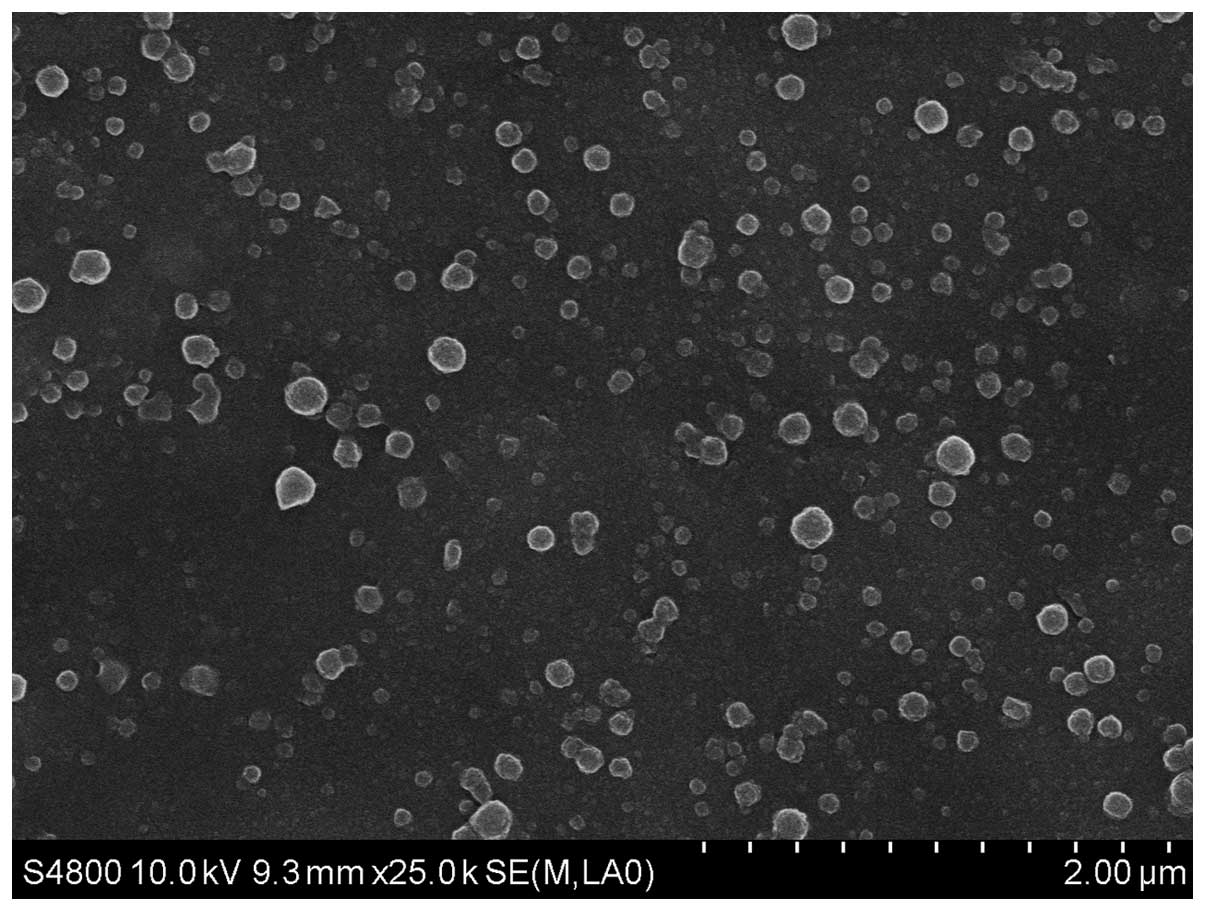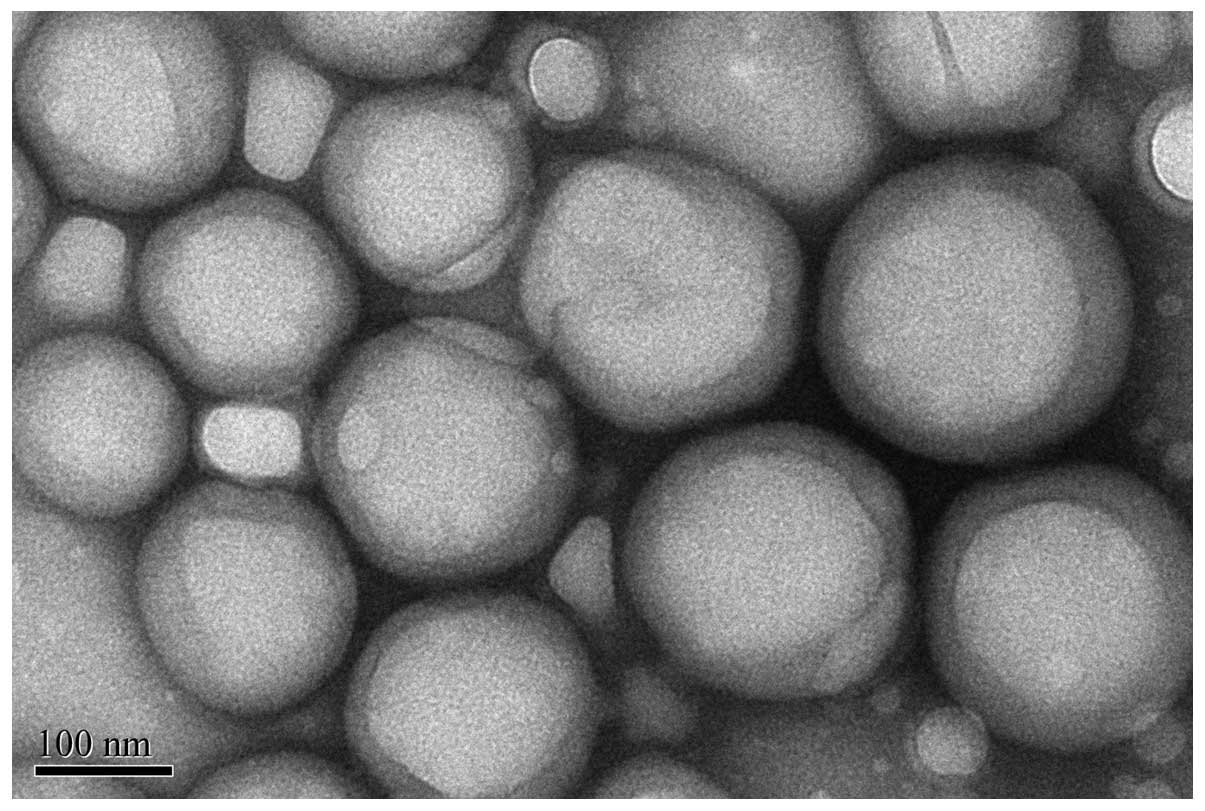|
1
|
Lencioni R, Piscaglia F and Bolondi L:
Contrast-enhanced ultrasound in the diagnosis of hepatocellular
carcinoma. J Hepatol. 48:848–857. 2008. View Article : Google Scholar : PubMed/NCBI
|
|
2
|
Nemec U, Nemec SF, Novotny C, Weber M,
Czerny C and Krestan CR: Quantitative evaluation of
contrast-enhanced ultrasound after intravenous administration of a
microbubble contrast agent for differentiation of benign and
malignant thyroid nodules: assessment of diagnostic accuracy. Eur
Radiol. 22:1357–1365. 2012. View Article : Google Scholar : PubMed/NCBI
|
|
3
|
Kornmann LM, Reesink KD, Reneman RS and
Hoeks AP: Critical appraisal of targeted ultrasound contrast agents
for molecular imaging in large arteries. Ultrasound Med Biol.
36:181–191. 2010. View Article : Google Scholar
|
|
4
|
Shive MS and Anderson JM: Biodegradation
and biocompatibility of PLA and PLGA microspheres. Adv Drug Deliv
Rev. 28:5–24. 1997. View Article : Google Scholar
|
|
5
|
Pisani E, Tsapis N, Paris J, et al:
Polymeric nano/microcapsules of liquid perfluorocarbons for
ultrasonic imaging: physical characterization. Langmuir.
22:4397–4402. 2006. View Article : Google Scholar : PubMed/NCBI
|
|
6
|
Basude R, Duckworth JW and Wheatley MA:
Influence of environmental conditions on a new surfactant-based
contrast agent: ST68. Ultrasound Med Biol. 26:621–628. 2000.
View Article : Google Scholar : PubMed/NCBI
|
|
7
|
Oeffinger BE and Wheatley MA: Development
and characterization of a nano-scale contrast agent. Ultrasonics.
42:343–347. 2004. View Article : Google Scholar : PubMed/NCBI
|
|
8
|
Sun Y, Zheng Y, Ran H, et al:
Superparamagnetic PLGA-iron oxide microcapsules for dual-modality
US/MR imaging and high intensity focused US breast cancer ablation.
Biomaterials. 33:5854–5864. 2012. View Article : Google Scholar : PubMed/NCBI
|
|
9
|
Néstor MM, Kei NP, Guadalupe NA, Elisa ME,
Adriana GQ and David QG: Preparation and in vitro evaluation of
poly(D,L-lactide-co-glycolide) air-filled nanocapsules as a
contrast agent for ultrasound imaging. Ultrasonics. 51:839–845.
2011. View Article : Google Scholar : PubMed/NCBI
|
|
10
|
Kohl Y, Kaiser C, Bost W, et al:
Preparation and biological evaluation of multifunctional
PLGA-nanoparticles designed for photoacoustic imaging.
Nanomedicine. 7:228–237. 2011. View Article : Google Scholar
|
|
11
|
Xu JS, Huang J, Qin R, et al: Synthesizing
and binding dual-mode poly (lactic-co-glycolic acid) (PLGA)
nanobubbles for cancer targeting and imaging. Biomaterials.
31:1716–1722. 2010. View Article : Google Scholar
|
|
12
|
Xu RX, Huang J, Xu JS, et al: Fabrication
of indocyanine green encapsulated biodegradable microbubbles for
structural and functional imaging of cancer. J Biomed Opt.
14:0340202009. View Article : Google Scholar : PubMed/NCBI
|
|
13
|
Sunoqrot S, Bae JW, Jin SE, Pearson MR,
Liu Y and Hong S: Kinetically controlled cellular interactions of
polymer-polymer and polymer-liposome nanohybrid systems. Bioconjug
Chem. 22:466–474. 2011. View Article : Google Scholar : PubMed/NCBI
|
|
14
|
Chu B: Laser Light Scattering: Basic
Principles and Practice. 2nd edition. Academic Press; 1991
|
|
15
|
Xu R: Particle Characterization: Light
Scattering Methods. Kluwer Academic Publications; 2000
|
|
16
|
Liu J, Levine AL, Mattoon JS, et al:
Nanoparticles as image enhancing agents for ultrasonography. Phys
Med Biol. 51:2179–2189. 2006. View Article : Google Scholar : PubMed/NCBI
|
|
17
|
Liu J, Li J, Rosol TJ, Pan X and Voorhees
JL: Biodegradable nanoparticles for targeted ultrasound imaging of
breast cancer cells in vitro. Phys Med Biol. 52:4739–4747. 2007.
View Article : Google Scholar : PubMed/NCBI
|
|
18
|
Hu H, Zhou H, Du J, et al: Biocompatible
hollow silica microsphere as a novel ultrasound contrast agent for
in vivo imaging. J Mater Chem. 21:6576–6583. 2011. View Article : Google Scholar
|
|
19
|
Doiron AL, Homan KA, Emelianov S and
Brannon-Peppas L: Poly(lactic-co-glycolic) acid as a carrier for
imaging contrast agents. Pharm Res. 26:674–682. 2009. View Article : Google Scholar
|
|
20
|
Kwon S and Wheatley MA: Gas-loaded PLA
nanoparticles as ultrasound contrast agents. IFMBE Proceedings.
14:275–278. 2007. View Article : Google Scholar
|
|
21
|
Wheatley MA, Forsberg F, Oum K, et al:
Comparison of in vitro and in vivo acoustic response of a novel
50:50 PLGA contrast agent. Ultrasonics. 44:360–367. 2006.
View Article : Google Scholar : PubMed/NCBI
|
|
22
|
Eisenbrey JR, Burstein OM, Kambhampati R,
Forsberg F, Liu JB and Wheatley MA: Development and optimization of
a doxorubicin loaded poly(lactic acid) contrast agent for
ultrasound directed drug delivery. J Control Release. 143:38–44.
2010. View Article : Google Scholar : PubMed/NCBI
|
|
23
|
Yuan F, Dellian M, Fukumura D, et al:
Vascular permeability in a human tumor xenograft: molecular size
dependence and cutoff size. Cancer Res. 55:3752–3756.
1995.PubMed/NCBI
|
|
24
|
Moore A, Marecos E, Bogdanov A Jr and
Weissleder R: Tumoral distribution of long-circulating
dextran-coated iron oxide nanoparticles in a rodent model.
Radiology. 214:568–574. 2000. View Article : Google Scholar : PubMed/NCBI
|
|
25
|
Zhou S, Liao X, Li X, Deng X and Li H:
Poly-D,L-lactide-co-poly (ethylene glycol) microspheres as
potential vaccine delivery systems. J Control Release. 86:195–205.
2003. View Article : Google Scholar : PubMed/NCBI
|
|
26
|
Cheng J, Teply BA, Sherifi I, et al:
Formulation of functionalized PLGA-PEG nanoparticles for in vivo
targeted drug delivery. Biomaterials. 28:869–876. 2007. View Article : Google Scholar
|
















